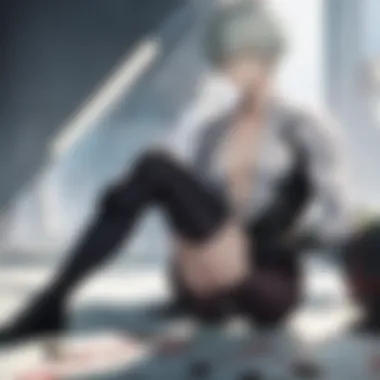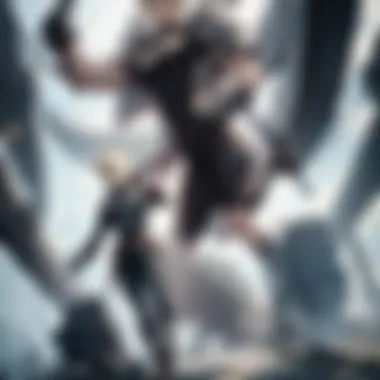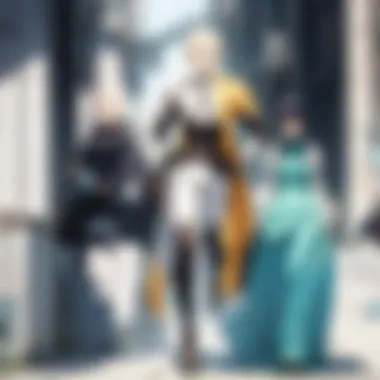In-Depth Review of One Punch Man Season 2 Episode 1


Intro
The world of anime often resonates deeply with its audience, and One Punch Man is no exception. As the long-awaited Season 2 begins, viewers expect not just more of the explosive action and wit that defined the first season but also an evolution in story and character. This article dives into the first episode of the second season, exploring the intricate details that make this anime unique. Through a thorough examination of character profiles, thematic elements, and animation quality, we will unpack the layers of this episode, giving insights that enhance both understanding and appreciation.
Character Profiles
Overview of Main Characters
The main character, Saitama, aka One Punch Man, continues to showcase his unrivaled strength. However, this first episode hints at a deeper struggle for Saitama. He is not just dealing with boredom and lack of challenge but begins to face the reality of being a hero in a world where recognition and support from the public are less certain.
Genos, Saitama's devoted disciple, maintains a significant presence. He reflects growth, both in his abilities and his understanding of heroism, capturing the importance of mentorship within the narrative. The relationship dynamics between Saitama and Genos deepen, providing a fresh layer to their interactions.
Supporting Characters
New characters emerge in this episode, including various heroes from the Hero Association. These heroes serve to expand the universe and introduce competition. Their motivations differ, adding complexity to the overarching theme of what it means to be a hero.
This episode presents a mix of old and new characters effectively, pushing the plot while also expanding the viewer's understanding of Saitama's contrasting position as both an extraordinary hero and a misunderstood individual in a society that often overlooks him.
Theme Exploration
Central Themes
At its core, this episode emphasizes the dichotomy between strength and recognition. Saitama's immense power does not translate to public admiration, leading to a reflection on societal values regarding heroism and fame. The theme of existential ennui also persists, highlighting the frustrations of those who find themselves not living up to their expectations or desires.
Cultural References
The episode subtly integrates cultural references that resonate with the audience. Notably, it critiques the nature of modern heroism through exaggerated portrayals of other hero characters. This approach serves as commentary on contemporary society’s obsession with celebrity culture and the pressures that come from it.
"In a world where strength does not equal respect, Saitama represents a unique challenge to these ideals."
Animation Quality
The animation in this episode is notably consistent with the established style of One Punch Man. Action scenes are fluid, displaying the intense battles with an emphasis on choreography. However, the contrast between detailed combat sequences and simpler animation in quieter moments maintains a balance. This blend adds depth, drawing the viewer's attention to both action and emotional resonance.
Culmination
The first episode of One Punch Man Season 2 sets a promising tone. It paves the way for further character development and thematic exploration, ensuring that both loyal fans and newcomers remain engaged. The focus on intricate character dynamics and societal reflection enriches the viewing experience, making the show not just an action-packed series but a thoughtful commentary on the nature of heroism. As the season unfolds, it will be intriguing to see how these elements evolve and impact the audience's engagement.
Preamble to One Punch Man
The topic of One Punch Man is essential for any discussion surrounding contemporary anime, especially considering its unique take on superhero narratives. This article focuses on how Season 2, starting with its first episode, expands upon the established themes, characters, and visual storytelling that defined the first season.
In understanding One Punch Man, it is important to recognize its blend of humor and action. This series is not just about a hero who defeats foes with a single punch; it also delves into deeper themes such as existentialism and the nature of strength. The analysis of Season 2 Episode 1 provides insights into how these themes evolve and manifest in a way that keeps the audience engaged.
The significance of the second season cannot be overstated. It plays a critical role in the series' ongoing narrative. New story arcs unfold, characters deepen, and the stakes evolve. Therefore, discussing the introductory episode allows for an evaluation of how well it sets the tone for the rest of the season.


Episode Synopsis
In discussing the Episode Synopsis of One Punch Man Season 2 Episode 1, it is important to understand how this section serves as the foundation for the entire analysis. By summarizing the key events, the audience gains a clear view of the narrative journey, essential for contextualizing character motivations and thematic undertones. This synopsis allows viewers to recall essential plot developments that can influence subsequent sections, such as character analysis and thematic exploration. It sets the stage for a deeper examination and provides a reference point for evaluating the episode’s success in advancing the overarching story.
Key Plot Points
The first episode of Season 2 unfolds with a few pivotal plot points that capture the essence of the series while setting up new arcs. Initially, the audience is reacquainted with Saitama, the protagonist, whose overwhelming strength and unique disposition continue to shape the narrative. His introspective moments are balanced against action, revealing his struggles with boredom and the search for meaning in heroism.
Another significant plot point involves Genos, Saitama's dedicated disciple, who remains earnest in his quest to improve himself. Together, they encounter a new threat that challenges their understanding of strength and heroism. The introduction of new characters, such as the members of the Monster Association, adds layers to the plot, presenting fresh conflicts that challenge established norms. This juxtaposition of old and new characters shapes the trajectory of their joint adventures.
Main Conflict Introduced
The main conflict introduced in this episode revolves around the emergence of the Monster Association. Unlike previous adversaries, this organization poses a more complex challenge. It tests the moral frameworks of established heroes, raising questions about the nature of good and evil. As Saitama confronts these new figures, the episode delves into the psyche of a hero ensnared by ennui.
The clash between Saitama's casual detachment and the unabashed ambition of the new villains serves as a catalyst for tension. This conflict hints at a broader examination of what it truly means to be a hero in a world where strength and purpose are in constant flux. By highlighting this dichotomy, the episode invites viewers to reflect on the motivations that drive both heroes and villains, establishing a thematic depth that resonates well beyond the first viewing.
Character Analysis
Character analysis is an essential component of understanding One Punch Man Season 2 Episode 1. It offers insights into the motivations, growth, and relationships of central figures within the story. By examining character dynamics, viewers can better appreciate how interactions shape the narrative and impact the unfolding plot. This section explores the two main aspects: Saitama’s development and the introduction of new characters, as well as their relationships.
Saitama's Character Development
Saitama, the protagonist of the series, presents a multifaceted personality that evolves throughout Season 2. In Episode 1, his existential crisis is evident. He battles boredom stemming from his overwhelming strength. His interactions showcase a blend of frustration and humor, highlighting his struggles despite being the most powerful hero.
This episode initiates a deeper exploration of Saitama’s psyche. His search for fulfillment prompts questions about heroism and purpose. Viewers witness a character who, while invincible, feels disconnected from the essence of being a hero. This inner conflict is significant because it sets the tone for the season and encourages the audience to reflect on what it means to be truly strong.
New Characters Introduced
One Punch Man Season 2 Episode 1 introduces several new characters that enrich the narrative landscape. Among them, characters like Garou emerge, presenting unique challenges to Saitama and his allies. Garou's motivations as a self-proclaimed monster add a new layer to the story. His perspective shifts the traditional view of hero and villain, urging viewers to reconsider their preconceived notions.
Additionally, the introduction of the Hero Association's new heroes, with their diverse abilities and backgrounds, creates opportunities for intriguing dynamics. These characters serve to contrast with Saitama, emphasizing his unparalleled power while also showcasing the varied responses to threats they embody.
Character Relationships and Dynamics
The relationships among characters in Episode 1 play a critical role in driving the narrative. Saitama's bond with his sidekick, Genos, is a focal point. Their mentor-student dynamic is marked by Genos's admiration and Saitama's nonchalant guidance. This relationship adds depth to Saitama, reminding viewers of his responsibilities, even in a lighthearted manner.
Moreover, interactions with new characters reveal various themes, such as loyalty, rivalry, and aspiration. For instance, the tension between Saitama and Garou illustrates the shifting landscape of heroism within the episode. Saitama's indifference contrasts sharply with Garou's ambition, creating an engaging juxtaposition.
Understanding these relationships enhances the viewer's ability to grasp the complexities of the One Punch Man universe.
Animation and Production Quality
The significance of animation and production quality in any anime series cannot be understated. For a show like One Punch Man, which is as much known for its action sequences and visual style as for its storytelling, the quality of the animation forms the backbone of viewers' experiences. In the context of Season 2 Episode 1, the animation becomes a lens through which we can evaluate changes in artistic direction, character design, and overall viewer immersion. This section delves into how these elements contribute to the narrative and thematic concerns established in this episode.
Comparison with Season One


In comparing the animation quality of Season 2 Episode 1 with that of Season One, several notable aspects stand out. The first season, produced by Madhouse, was lauded for its fluid and dynamic animation, especially during fight scenes. Viewers were treated to intense sequences that showcased both the power of characters and the depth of their abilities. In contrast, the second season transitions to J.C. Staff as the studio responsible for the animation. Some fans have criticized this shift, suggesting that the fluidity and detail observed in the first season may not be as prevalent here.
- Visual Consistency: Critics argue that the character designs appear slightly different from Season One. This inconsistency can distract viewers who are accustomed to specific character aesthetics.
- Fight Choreography: While the fight scenes in the second season maintain a level of excitement, they do not reach the same heights as those in the first season. Some action sequences come off as less impactful due to noticeable changes in animation techniques, particularly in timing and fluidity.
- Overall Detailing: The environments in Season 2 are beautifully drawn but may lack the intricate details that fans appreciated in the first season. The background art sometimes appears less vibrant, which could impact the storytelling quality.
Notable Animation Techniques
Despite some critiques, there are also notable animation techniques employed in Season 2 Episode 1 that warrant discussion.
- Enhanced Use of Color: The color palette seems more vibrant in this episode, injecting life into various scenes and elevating the overall aesthetic. This enhances the show's ability to convey mood and tone effectively.
- Character Movement: There are instances where the character movement feels more grounded. This choice parallels the thematic shift from pure action to deeper storytelling. The subtleties in expressions and movements add a layer of relatability, reflecting the characters' personalities and emotional states.
- Special Effects: The episode utilizes special effects to emphasize character powers and abilities. While not always as lavish as the first season, the effects in Season 2 still hold a high standard, contributing to the show's identity.
"Animation serves as the visual language of One Punch Man, conveying narrative depth that may not always be expressed through dialogue."
Themes Explored in the Episode
In the realm of anime, themes serve as anchors for narrative progression, helping to frame character motivations and broader societal reflections. In "One Punch Man Season 2 Episode 1," a variety of themes materialize, enriching the viewing experience and allowing for deeper engagement with the material. From existential dilemmas to the intricate dance of humor amid serious narratives, the themes establish a complex narrative architecture that invites both critical analysis and personal reflection. This section dissects these themes, taking a detailed look into their significance in the overarching narrative.
Existential Themes in One Punch Man
The core of "One Punch Man" has always been the exploration of what it means to be powerful in a world teeming with threats. Season 2 Episode 1 continues this exploration, particularly through the character of Saitama, who embodies a unique existential crisis. Despite being the strongest hero, he grapples with feelings of boredom and a lack of fulfillment. This paradoxical existence serves as a poignant commentary on the nature of strength and achievement, invoking questions about purpose and the intrinsic value of work.
These themes resonate beyond the superficiality of heroics, asking viewers to consider deeper philosophical questions. What does it mean to find meaning in triumph? How do we reconcile our abilities with our desires? Saitama's journey, interwoven with the challenges he faces, reflects the human experience of searching for significance in a seemingly indifferent universe. The writers use these existential undertones to create a rich narrative that resonates with audiences on multiple levels.
Comedic Elements Within Serious Contexts
The juxtaposition of comedy and serious themes is a hallmark of "One Punch Man." This episode demonstrates that the integration of humor can effectively diffuse tension while simultaneously driving deeper insights into the characters and plot. Saitama's deadpan delivery and nonsensical encounters with powerful foes infuse levity that contrasts with the more somber undertones of the narrative.
For instance, during moments of intense confrontation, the series employs absurd humor that catches viewers off-guard. This craft is not merely for comedic relief but serves a significant thematic purpose. It amplifies the absurdity of Saitama's existence and prompts viewers to grapple with both laughter and reflection.
Humor in heavy contexts makes the narrative more accessible, allowing audiences to digest complex themes without feeling overwhelmed.
The effectiveness of this comedic strategy highlights how juxtaposition can deepen the viewer's engagement with the story. The overarching tension in the dialogues emphasizes the reality of Saitama's struggles, reinforcing that even in the face of adversity, humor can play an essential role in overcoming existential despair. Overall, this thematic duality enriches the narrative and invites viewers to ponder the serious questions surrounding life and personal fulfillment.
Cultural Impact
The cultural impact of One Punch Man extends beyond its immediate reception and can be felt in various aspects of the anime and wider entertainment landscape. This impact showcases how the show resonates with audiences and influences discussions within the anime community. The intricate blend of humor and action, paired with strong character arcs, has generated extensive discourse on both social media and forums.
Audience Reception and Reviews
Audience reactions to Season 2 Episode 1 demonstrate a mixed response, reflecting both excitement and critique. Many viewers express satisfaction with the continuation of Saitama's journey. Others, however, note differences from the initial season, particularly in animation quality and pacing. Online platforms like Reddit and Facebook have become venues for debates regarding the episode’s overall effectiveness. Reviews often cite moments that resonate deeply, such as the interplay of comedic and serious tones, a hallmark of the series.
Positive reviews typically highlight how the episode maintains the series' essential humor despite the evolving plot arcs. The production quality has sparked discussions as well, with some praising specific animation sequences while others call for similar fluidity as seen in the first season. On aggregate, the reception serves as an indicator of audience expectations moving forward.
Influence on the Anime Community
One Punch Man's influence on the anime community is noteworthy. The series has not only set a benchmark for superhero narratives in anime but also shaped trends in character development and storytelling. The unique format of mixing comedy with substantial themes has inspired many creators in the genre.


Anime discussion boards and community groups have seen increased activity surrounding the episode, allowing fans to explore themes presented in the storyline. This interaction between fans fosters a sense of community and shared enthusiasm. The character of Saitama, in particular, has become an archetype for anti-heroes, prompting discussions about the nature of power and purpose.
In summary, the cultural impact of One Punch Man is evident through audience reception and its thoughtful engagement within anime circles. The discussions around the series facilitate a greater understanding of how animation can influence cultural narratives and trends, reinforcing the significance of One Punch Man as both a piece of art and commentary.
Comparative Analysis with Manga Source Material
The comparative analysis between the anime adaptation of One Punch Man and its manga source material is crucial for understanding the nuances of character portrayal and plot development in Season 2 Episode 1. While both mediums share core elements, notable differences emerge that influence the viewer's experience. These differences can highlight artistic choices and narrative pacing that could shift audience perception and engagement.
Plot Differences Noted
In Season 2 Episode 1, several key plot deviations from the manga become evident. One significant difference includes the introduction of new characters. The anime takes a more gradual approach to integrate these characters into the plot, allowing time to establish their backgrounds and motivations. This could create a sense of anticipation for viewers who have not read the manga, whereas manga readers might find these introductions less impactful due to their prior knowledge.
Additionally, certain events are reordered in the anime. For instance, interactions between Saitama and his allies occur at different points in the story. This adjustment affects the narrative's flow, possibly adding suspense for the audience who may not be fully aware of future developments.
Another notable change involves the presentation of action scenes. The manga often conveys intense moments in a more rapid-fire succession, whereas the anime exhibits a more calculated pacing, focusing on emotional weight and character reactions. This can result in a different atmosphere, reflecting the thematic elements intended by the creators.
Character Adaptations from Manga to Anime
Character adaptations from the manga to the anime also warrant discussion, particularly in how personalities and motivations are depicted. For example, Saitama's laid-back demeanor in the manga translates into humorous yet straightforward moments in the anime. However, some subtleties in his character are slightly diluted in the transition. The anime sometimes emphasizes his reactions in situations, making some scenes feel less nuanced than long-time readers might expect.
Furthermore, newly introduced characters, such as Garou, are depicted with depth in the manga. The anime, while still capturing his essence, tends to streamline his complexity to fit the episode's limited timeframe. This can lead to oversimplification, which might disappoint manga readers looking for a more comprehensive exploration of his motivations.
The animation itself also influences character expression. The ability of the animated medium to emphasize movement and facial expressions provides a different layer of persona. In contrast, manga relies heavily on visual artistry and reader interpretation, which can create a more subjective experience.
"Understanding these differences can deepen one's appreciation of how adaptations transfer narrative and character from one medium to another."
Culmination
The conclusion of an analysis of One Punch Man Season 2 Episode 1 serves as a critical summation of the insights gathered throughout the article. It highlights the thematic and narrative shifts introduced in this season, which set the stage for future developments within the series. This episode begins with notable shifts in character dynamics, particularly in Saitama's interactions and the emergence of new threats.
In addition, the assessment of animation quality brings attention to the production values that can affect viewer engagement. By discussing the implications of these artistic choices, readers can appreciate the effort behind the animation. The conclusion also addresses the potential ramifications of the events that unfold in this episode for character arcs and future plotlines.
Ultimately, summarizing the episode's significance not only enhances the reader's understanding but also emphasizes how it contributes to the overall narrative of One Punch Man. This information is crucial for both casual viewers and manga enthusiasts who are keen to understand the numerous threads connecting various story elements.
Final Thoughts on Episode One
The first episode of Season Two marks a pivotal moment in the One Punch Man series. It offers viewers an opportunity to re-engage with familiar characters while introducing new elements that provoke thoughtful consideration. Saitama, as the perennial hero, remains at the center. Yet, the complexities surrounding his interactions with others reveal different layers of his character.
Moreover, the stakes feel elevated as the looming threat of the Monster Association is introduced early. This not only raises tension but also suggests that previous ideologies regarding heroism may be challenged. The blend of comedy and action persists, continuing to intrigue audiences who appreciate the series' unique tone.
Expectations for Future Episodes
Moving forward, expectations for the subsequent episodes are substantial. As new characters are integrated into the story, their influence on Saitama’s journey will be significant. The expected character development and interaction are central to maintaining viewer interest. Additionally, as the conflict with the Monster Association develops, it will be essential to see how Saitama and other heroes respond.
Furthermore, the exploration of existential themes might deepen, compelling audiences to reflect on what true strength represents in this universe. The interplay of humor amidst darker circumstances offers a fresh take on the superhero genre, and viewers eagerly anticipate how that will unfold.
Engagement with the anime community will also shape expectations. Fans will likely discuss and dissect ongoing plot developments and character arcs, enhancing the collective viewing experience.
"The next episodes promise to delve deeper into the essence of heroism and its implications, as seen through varied lenses of both new and existing characters."
In sum, this episode not only sets a promising tone for Season Two but also lays the groundwork for much deeper explorations ahead.







